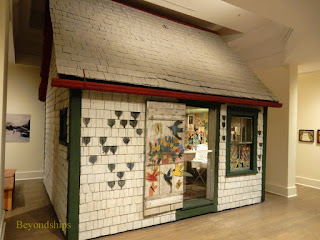On a recent
visit to the Art Gallery of Nova Scotia (ADNS), I was introduced to
the works of Maud Lewis. Maud was a talented Canadian folk artist
with a compelling story. Indeed, her story is so compelling that
recently a movie, “Maudie,” was made about her life.
Maud Dowley was born in 1903 in rural
Nova Scotia. She was born small and with hardly any chin. These
difficulties were compounded when she was stricken with juvenile
arthritis causing her joints to swell and deforming her hands. This
condition worsened throughout her life.
Most likely to avoid the taunts of
other children, Maud spent most of her childhood by herself or with
her immediate family. She was introduced to art by her mother who
painted Christmas cards to supplement the family income. Painting
became a passion for Maud.
After the death of her parents, Maud
lived with her brother and with her aunt for a time. But then in
1938, she married Everett Lewis, an itinerant fish peddler, who she
probably met when he made a delivery to her aunt's house.
She moved into Everett's tiny house
near the local “poor house.” It had no electricity, no indoor
plumbing and was heated only by a wood burning stove.. Maud's
disabilities prevented her from doing the housework so that became
Everett's responsibility. Maud concentrated on her paintings.
The primary vehicle for selling her
art was a roadside sign saying “Paintings for Sale.” Her works
were also available through a local store and Everett sold her
hand-painted holiday cards from his wagon while making his deliveries
of fish. The paintings were sold for a couple of dollars each.
Despite the limited reach of these
marketing efforts, such was the power of Maud's work that journalists
began to write about her and she gradually became known for her art.
This enabled her to purchase better quality materials and a slight
improvement in lifestyle. However, Everett and she continued to live
in the same rural community.
Maud died in 1970.
The Art Gallery of Nova Scotia has a
large collection of Maud's works. Maud had no formal art training
and her exposure to paintings by others was pretty much limited to
what happened to be published in magazines. Thus, her works do not
reflect any artistic movement or school of thought. Rather, they are
flat images that have the simplicity of the early 19th
century North American folk paintings. In some respects, they are
similar to the works of Grandma Moses.
Maud had a great sense of color and of
composition. These combine to form happy images of rural life - -
portraits of cats, teams of oxen, covered bridges, horse drawn
sleighs, churches, rural landscapes and pictures of the sea shore.
Nowhere is there a hint of the difficult life that she endured.
Perhaps it would be better to say
overcame rather than endured. These images reflect a triumph of the
spirit over adversity.
This is underscored in the centerpiece
of the exhibit - - the house in which Maud and Everett lived for 30
years. After Everett's death, a private group bought the house and
donated it to the Province of Nova Scotia. Following several years
of conservation work, the house was re-assembled inside of the Art
Gallery of Nova Scotia.
It is indeed a tiny house. I have
seen children's playhouses that were larger. As mentioned earlier,
it had no modern amenities. However, there is a lot of love in this
house. Maud painted not just the outside of the house but also the
interior including the stove. Images of flowers speak of beauty and
happiness.
Inside the house, you can see some of
the tools Maud used to create her art such as sardine cans used in
mixing paint. Until she achieved some recognition, her materials
were house paint, boat paint and hobby brushes.
The Maud Lewis Gallery at the AGNS is
thus of interest in two ways. First, there are the paintings
themselves. They are pleasing images on a stand alone basis without
reference to the artist's story. Second, it tells an inspirational
story.


Comments
Post a Comment